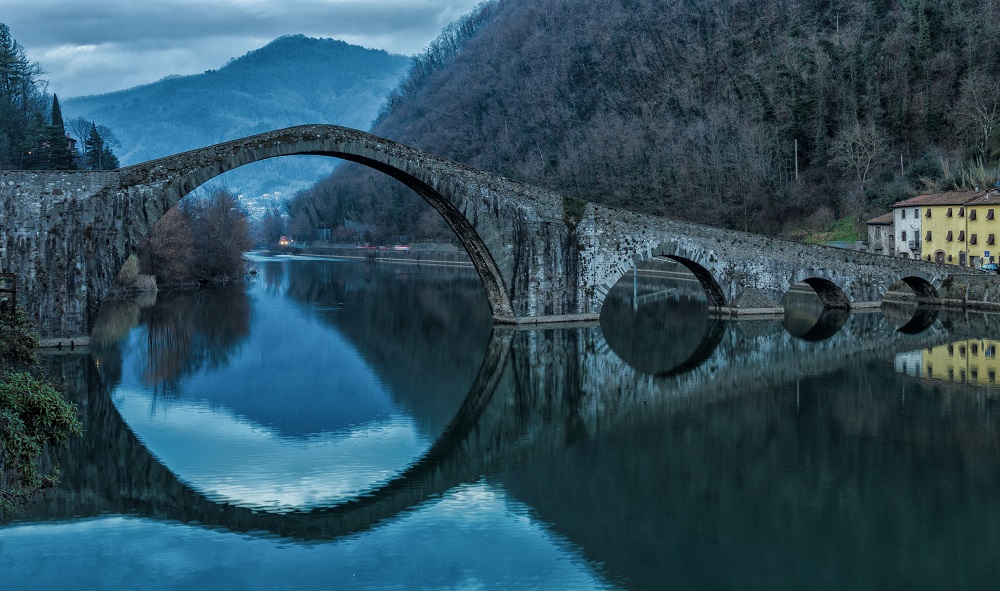
|
Zpět do galerie |

|

Člen fotoklubu
| Peter Netopier
Profil |
|
| Název: | Most Maddalena/Ponte della Maddalena (Ponte del Diavolo)/ |
| Popis: | tzv. diablov most, nachadza sa v toskansku nedaleko od mesta Lucca, localita Borgo a Mozzano, |
| Vloženo: | 2015-01-25 18:56:39 |
| Zobrazení: | 1926 |
| Komentáře: | 8 |
Technika
| Kamera: | D5100 |
|---|---|
| Objektiv: | 35mm f1.8 G |
| Rychlost závěrky: | 1/2 |
| Clona: | 10 |
| ISO: | 100 |
| Kategorie: | Reportáž |
moc líbí 













je to zajímavé
veľmi zaujímavé foto


 zajímavé
zajímavé
velmi pekna hystoria tohto mostu no nevim ako vam to prelozi v prekladaci... mne po slovensky vychadzali same hluposti... ciao pekny vecer ... peter
The story: The bridge spans the river Serchio Maddalena near Borgo a Mozzano, in the province of Lucca (see gallery). And 'outstanding work of medieval engineering, probably commissioned by Countess Matilda of Canossa. Was it restored in the thirteenth century by Castruccio Castracani. The bridge is named after a newspaper stand, which housed inside the figure of Mary Magdalene, built around 1500 and which no longer exists. In the centuries has been altered several times, putting at risk the structure. An act of 1670 the Republic of Lucca forbade get over with millstones: the intent was to preserve it in its integrity. At the beginning of '900, to pass the railway line Lucca -Aulla, was opened a new arc, who modified significantly the physiognomy. The structure, bold, arched asymmetrical, with the central arch that defies gravity, has endured over the centuries countless floods and, even today, the bridge is in walking due to its shape to "humpback" . Legend: The sinister name of Devil's Bridge is due to a legend of which there are several versions. The best known is the one that takes us back to his house: it is said that the task of building the bridge was entrusted to St. Julian the Hospitaller. The work proved difficult from the beginning of creation. The foreman in charge of the work, realizing that it would complete the work for the deadline, it had sunk into despair, but one evening, as he sat alone on the bank of the Serchio, thinking about the shame that would be derived for not finishing the bridge in time, the devil appeared to him, who asked him to sign a pact. The evil would have finished the bridge in a single night, but on one condition: he would take the soul of the man who had crossed the bridge first. The pact was signed: in one night the devil with his fork lifted the great span of the bridge. The manufacturer, full of remorse, went to confession to a priest, who told him to respect the pact, but he had the foresight to have to cross the bridge to a first? pork. The next day the foreman prevented access to people and caused him to cross the first bridge to the beast. Legend has it that the devil, enraged by the insult, it is thrown off the bridge into the waters of Serchio and was not done to see again in these parts.
La storia: Il ponte della Maddalena scavalca il fiume Serchio nei pressi di Borgo a Mozzano, in provincia di Lucca (vedi galleria). E' un'eccezionale opera di ingegneria medioevale, probabilmente voluta dalla contessa Matilde di Canossa. Fu fatto restaurare nel secolo XIII da Castruccio Castracani. Il ponte deve il nome ad una edicola, che custodiva al suo interno la figura della Maddalena, costruita intorno al 1500 e oggi non più esistente. Nei secoli è stato più volte rimaneggiato, mettendone a rischio la struttura. Un atto del 1670 della Repubblica di Lucca proibiva di passarci sopra con le macine di mulino: l'intento era di preservarlo nella sua integrità. Agli inizi del '900, per far passare la linea ferroviaria Lucca -Aulla, fu aperto un nuovo arco, che ne modificò notevolmente la fisionomia. La struttura, ardita, ad arcate asimmetriche, con l'arco centrale che sfida la forza di gravità, ha resistito nei secoli a innumerevoli piene e, ancora oggi, il ponte è percorribile a piedi grazie alla sua forma a "schiena d'asino". La leggenda: Il sinistro nome di Ponte del Diavolo è dovuto a una leggenda di cui esistono varie versioni. La più nota è quella che ci rimanda alla sua costruzione: si narra che il compito di edificare il ponte sia stato affidato a S. Giuliano l'Ospitaliere. L'opera si rivelò fin dall'inizio di difficile realizzazione. Il capomastro incaricato dell'opera, resosi conto che non avrebbe completato il lavoro per la scadenza prevista, era sprofondato nella disperazione: ma una sera, mentre sedeva da solo sulla sponda del Serchio, pensando al disonore che gli sarebbe derivato per non aver terminato il ponte in tempo utile, gli apparve il diavolo, che gli propose di stipulare un patto. Il maligno avrebbe terminato il ponte in una sola notte, ma ad una condizione: avrebbe preso l'anima di colui che avesse attraversato il ponte per primo. Il patto fu siglato: in una sola notte il diavolo con la sua forca sollevò la grande campata del ponte. Il costruttore, pieno di rimorso, andò a confessarsi da un religioso, che gli disse di rispettare il patto, ma di aver l'accortezza di far ad attraversare per primo il ponte a un? maiale. Il giorno successivo il capomastro impedì l'accesso alle persone e fece attraversare per primo il ponte alla bestia. La leggenda vuole che il diavolo, inferocito per la beffa, si sia gettato giù dal ponte nelle acque del Serchio e non si sia fatto rivedere mai più da quelle parti.


